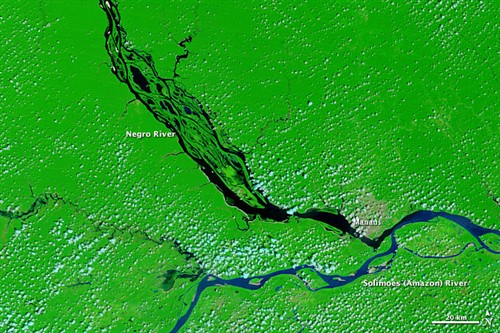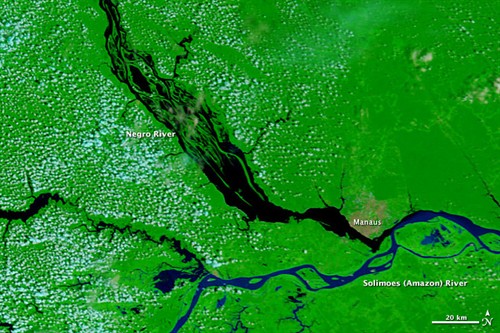A severe drought across the Amazon rainforest in 2010 has devastated swathes of the two million square mile region. New research published in Science reports on dry riverbeds, millions of dead trees and an increased number of wildfires. The sum-total of these environmental changes meant that instead of absorbing carbon, as the ‘lungs of the Earth’ usually does, the Amazon will emit over 8 billion tonnes of CO2 as a result of the drought, more than China emitted in 2009.
The Daily Mail states, “Around 60,000 people went hungry as water became contaminated and millions of fish died,” while, “The dry spell was also disastrous for trees, amphibians and other wildlife.” River levels were so low it caused more than 20 municipalities to declare a state of emergency. In 2005, the Amazon suffered what was described as a ‘once in a century’ drought, however, the dry period in 2010 appears to have been more damaging. Although the research is still at an initial stage, satellite images here indicate the afflicted areas of the forest are considerably larger.

The Rio Negro river in 2010 (above), and 2008 (below). The river reached a record low this year. via NASA Earth Observatory.

The Guardian reports, “the vast forest is on the verge of a tipping point, where it will stop absorbing greenhouse gas emissions and instead increase them.” When alive, trees are able to store CO2 and normally the Amazon would be expected to absorb approximately 1.5 billion tonnes a year. But when trees die CO2 is released back into the atmosphere. In cases of extreme drought such as this one, millions of trees were killed and consequently around 8 billion tonnes of CO2 were emitted.
Researchers fear that if droughts like this continue to happen in the future the Amazon will cease to be a valuable “carbon sink” and instead become a formidable emitter of CO2. Such a change would make it significantly harder for the world to reduce emissions and mitigate climate change. But a definitive link between the two recent droughts and long-term climate change has not been established. Dr Simon Lewis, the project’s lead researcher, commented:
“One possibility is that this is just a natural climatic variation and in the future we might not see any more of these type of droughts. The alternative is it’s associated with high greenhouse gas concentrations in the atmosphere, it’s related to climate change and if that’s the case then we will see these droughts increasing in intensity and frequency into the future.”
Lewis also remarks,
“Having two events of this magnitude in such close succession is extremely unusual, but is unfortunately consistent with those climate models that project a grim future for Amazonia.”
Lewis and co-author Dan Nepstad previously intervened over a Sunday Times story claiming the IPCC was making bogus claims about the Amazon being sensitive to changes in rainfall – an incident described by sceptic lobbyists and commentators as ‘Amazongate‘.
At the time Lewis stated that “the IPCC statement itself is poorly written, and bizarrely referenced, but basically correct … Indeed, some leading models of future climate change impacts show a die-off of more than 40% Amazon forests…”
Lewis complained to the Press Complaints Commission about the article, which was subsequently retracted by the Sunday Times which also published an apology.
Substantial changes to the Amazon caused by drought are potentially irreversible and would have serious consequences for the world’s effort to reduce anthropogenic global warming. Further research into the full effects of the 2010 drought is on going with more results expected later this year.

